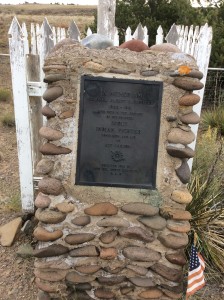
When we first moved to South Fork, Colorado, we moved into a huge house. One way too big for us, but it was 2011 after the 2008-2009 crash, and South Fork had yet to recover. Real Estate was cheap.
I sensed a presence immediately. It was feminine energy, full of life and happiness. When our granddaughter visited, I often heard her downstairs talking and giggling with someone. “Who are you talking to?” I asked.
“A nice lady,” she replied. I knew she was spending time with my ghost.
We sold The Ranch house last summer and downsized, but several years before, I started a search to discover who the nice lady was. I found a connection between my ghost and the famous Colonel Pfeiffer.
The Colonel
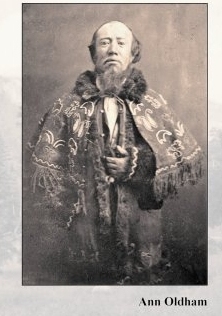
If you know nothing about Colonel Pfeiffer and want to find out more about a truly great and colorful American hero, you might enjoy doing a little investigation on him. There is no one quite like him in the chronicles of our history. Here are a few quick facts about him.
- He came to American at 22 from the Netherlands in 1844.
- Two years later in Santa Fe, New Mexico, he joined the Army and rose to the rank of colonel.
- In 1856 he met a beautiful Spanish woman and married her. They had one son and adopted three Native American children, two girls and a boy.
Tragic Day
In 1863, authorities placed the Colonel in charge of Fort McRae (current day near Truth or Consequence, NM). On one seemingly uneventful June morning — while bathing in the hot springs near Taos, NM — raiding Mescalero Apaches surprised Colonel Pfeiffer. The Apaches captured his pregnant wife, one of his adoptive daughters, and another woman and later killed them.
An Account
An accounting of the tragic events follows.
“Capt. Pfeiffer had just time to seize his rifle and wade across the river in pursuit of the Indians. He struck out without a stitch of clothing on, and the sun blazing hot. Knowing the Indian character, he thought the Indians would not kill his wife immediately, but would take the women to their hiding place and compel them to do menial labor; therefore, he made for the Fort to give the alarm and get reinforcements. He was followed by the Indians, who shot at him, one of the arrows entering his back with the end coming out in front. This wound troubled him for years afterward.
In this condition with the arrow in his back, he ran, until he reached an enclosure of rock where he made a halt to rest and to defend himself. He remained there for several hours, with the sun burning down upon him. He was known to the Indians as an excellent marksman and when they found they could not get him out of the stronghold without losing several of their number, they gave up the siege, which gave him his opportunity to escape to the post, about nine miles away. He reached the fort more dead than alive. When the surgeon drew out the arrow from his back the sun-scorched skin surrounding the arrow wound came off with it, and for days he suffered intense agony, and lay for two months at the point of death from this experience.” This was given by Md. Chester Mathias, as related to her by Elizabeth Chamberlin Pfeiffer (Lizzie Pfeiffer was the Colonel’s daughter-in-law.)
The Colonel’s Famous Battle
Colonel Pfeiffer served under Colonel Kit Carson. They were lifelong friends.
He later became close friends with the Utes, in particular the famous Chief Ouray. They called him Tata Pfeiffer. (ProbeNote: I think Tata means “father.”)
One fight for which the Colonel is most famous involved him fighting a young Navajo warrior. Unrest was breaking out near Pagosa Springs, Colorado, between the Navajos and the Utes over possession of the hot springs there.
After days of fighting, the Utes went to Colonel Pfeiffer for help. They agreed each tribe would select their best warrior to battle for rights to the springs for their tribe. The winner of the fight entitled his tribe to take possession of the springs.
The Battle
The Navajo picked their finest, most seasoned warrior.
The five-foot-five, forty-four-year-old Colonel volunteered to represent the Utes. They fought the battle with Bowie knives, and — at the Colonel’s request — naked. One account reports: The young warrior took one look at the grizzled body covered with many battle scars and was so intimidated Pfeiffer easily defeated him.
In 1872, Colonel Pfeiffer homesteaded land west of Del Norte, Colorado, where he died in bed at 59, battle scarred and body worn.
Jim Perkins, author and historian, said of Pfeiffer’s death, in 1881:
…in bed — not among the cactus and rocks in some lonely place — was a miracle in itself.
ProbeFiling
What does this have to do with the ghost who haunted The Ranch House? The Ranch House is less than a mile from the Colonel’s gravesite, in a direct line — as the crow flies — from his resting place.
(ProbeNote: Most lifelong residents of South Fork and Del Norte, Colorado claim that The Colonel’s body no longer occupies the grave but that history buffs moved it to a safer location to prevent tampering. However, according to the curator at the Del Norte Museum, his bones do indeed rest on that hilltop among the sage and tumbleweeds.)
But a Female Presence?
What I couldn’t figure out, until further investigation, was why I sensed a female presence and not the Colonel’s. I discovered that the Colonel’s son, Albert H. Pfeiffer, Jr., and his wife Elizabeth lived on the homestead with the Colonel. A biography about her says:
Lizzie tenderly cared for her father-in-law, Colonel Pfeiffer, until his death, and could recount endlessly his famous exploits which he spent so much time in telling her.”
I believe Lizzie’s spirit is still roaming the beautiful Colorado high country. She does so because here is where she lived and cared lovingly for her family.
At the time of my investigation, we were the only homeowners who lived full time on the old Pfeiffer homestead. Perhaps this is the reason she picked The Ranch House. Her love of people brought her to us.
Lizzie Pfeiffer
Accounts of Lizzie describe her as having a ready wit and gay manner. Someone who valued friendship and possessed a personality which people gravitated toward. Having such a love of life, maybe Lizzie chose to stay in this dimension a bit longer before beginning her next journey.
One month to the day separates Lizzie’s death and my birth. She liked to activate our fire alarms and cause our electronics to malfunction. Unusual smells often permeated our surroundings. I swear I can almost hear her giggle.
My little Chihuahua, Stella, sensed her and reacted — hiding, whimpering, and shaking — just before Lizzie started her mischief making.
If we left for any extended amount of time, we came home to broken lamps or non-functioning appliances like brand new coffee pots that suddenly quit working.
The day I made my discovery, Lizzie confirmed my hunch. At that enlightened moment, I whispered, “Lizzie, is that you?” The lights went off and came back on with one deliberate and intense flick. It was a bright, sunshiny day in the high country. There was no reason for a power surge. She affected nothing else except the lights in my office.
Priceless Treasure
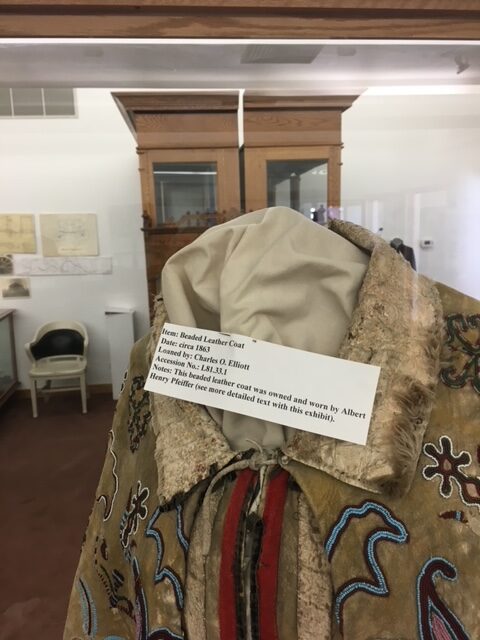
(ProbeNote: Notice the coat Colonel Pfeiffer is wearing in the top photo. His son is wearing it in the photo with Lizzie. Lizzie loaned this treasure — an Apache coat with bead work, now priceless — to the museum in Del Norte. She wanted to do this because it is a lost American Indian art form. And also because the colonel killed the Chief who wore it. This coat is now on display at the Rio Grande County Museum in Del Norte, Colorado, along with two letters written by Kit Carson to Colonel Pfeiffer.)
Update: The Other Side
Before leaving the Ranch House, my husband’s cousin, a Shamanic Healer, and his wife, a Reiki master, visited us. Both are highly sensitive to that other dimension where the unexplainables reside.
I told them about Lizzie. After a day and a night at the Ranch House, they acknowledged they perceived the feminine energy of Lizzie and that she was happy.
What concerned them the most was they also sensed a male spirit who wanted to crossover. This spirit was a Native American in search of his daughter. The Shaman could see him attired in breechcloth and a headband with a black feather.
After many questions, much thought and countless theories, we determined the spirit was the father of one Pfeiffer’s adopted daughters. Decades of searching for her had led him to our home. I concluded when I initially researched Pfeiffer; the spirit sensed my intent and came looking for answers.
Pfeiffer had adopted three Native American children, as mentioned above. Two were girls. One was captured by renegade Mescalero Apaches. I venture to say it was the kidnapped child for whom the father searched.
Crossover Ceremony
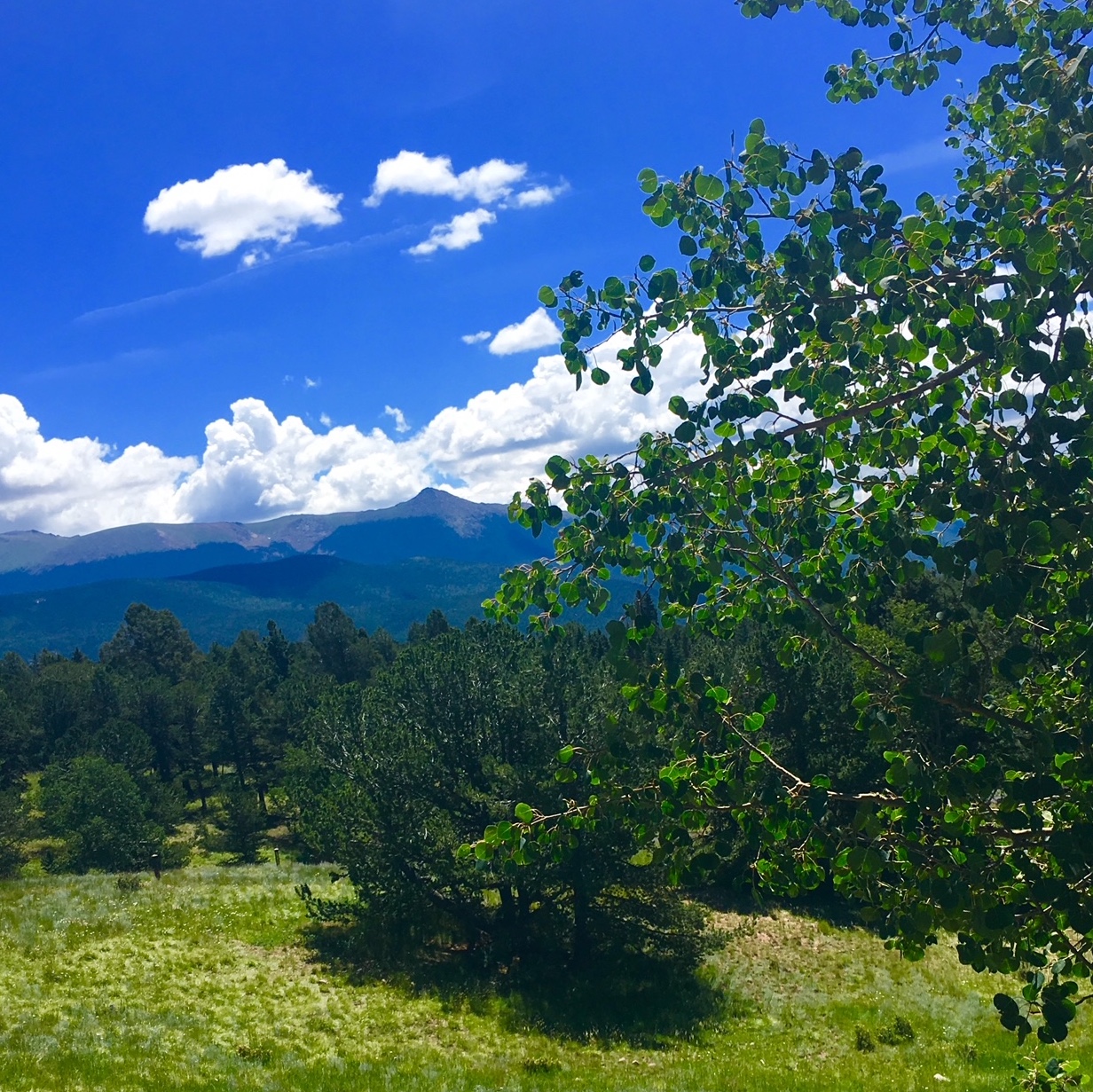
Apparently, the father’s spirit received the answers for which he longed, because he was now ready to crossover. The Shaman, the Reiki Master, my husband, and I held hands and formed a circle outside in the grass, surrounded by majestic mountains and a myriad of pinyons. Within seconds the jays quit their squawking, the wind stilled, and silence rested on every rock, blade of grass, and pine needle.
With coaching from the Reiki Master, we visualized a bridge. The Shaman invited the father’s spirit to cross. My husband, who is not sensitive to that other dimension, saw the spirit — dressed exactly as the Shaman had described — climb atop the bridge and walk solemnly across to the other side.
The rest of us present saw a flash of brilliant, indigo light at the moment the father reached the end of the bridge. In that moment, the jays began their chatter, a breeze mussed our hair, and the grass whispered, he is gone. Gone. Gone. A single black feather remained in the middle of the circle.
We didn’t speak for hours, exploring the experience introspectively. Puzzling was why the father appeared to my husband. My thought was, if my husband said he saw him rather than those of us who are already sensitive to that realm, we would know for sure the crossover was successful
In this way, the father showed his gratitude for our help — and, of course, with the offering of his sacred feather.
Afterwards
In the months that followed, Lizzie grew quiet. My husband invited her to come with us when we moved. That seemed to make her happy, but she did not follow us. We had no more power outages or electrical malfunctions. No more flickering lights or unusual smells.
One day I will ask the people who bought our home if they have experienced any unexplainable occurrences. In the meantime, I’m left wondering: Was it the father who caused the mischief as Lizzie watched and giggled. My guess is, yes.
The Probe’s Mission Statement
The Probe is devoted to:
- the exploration of the unexplainable,
- finding the truth in occurrences that resemble science fiction,
- researching and reporting on topics that could be flung upon the wall of weird.
- Coghlan’s Traveling Coffin Urban Legend - April 4, 2024
- Richmond Vampire Urban Legend - March 7, 2024
- Lick Lick Urban Legend - February 8, 2024
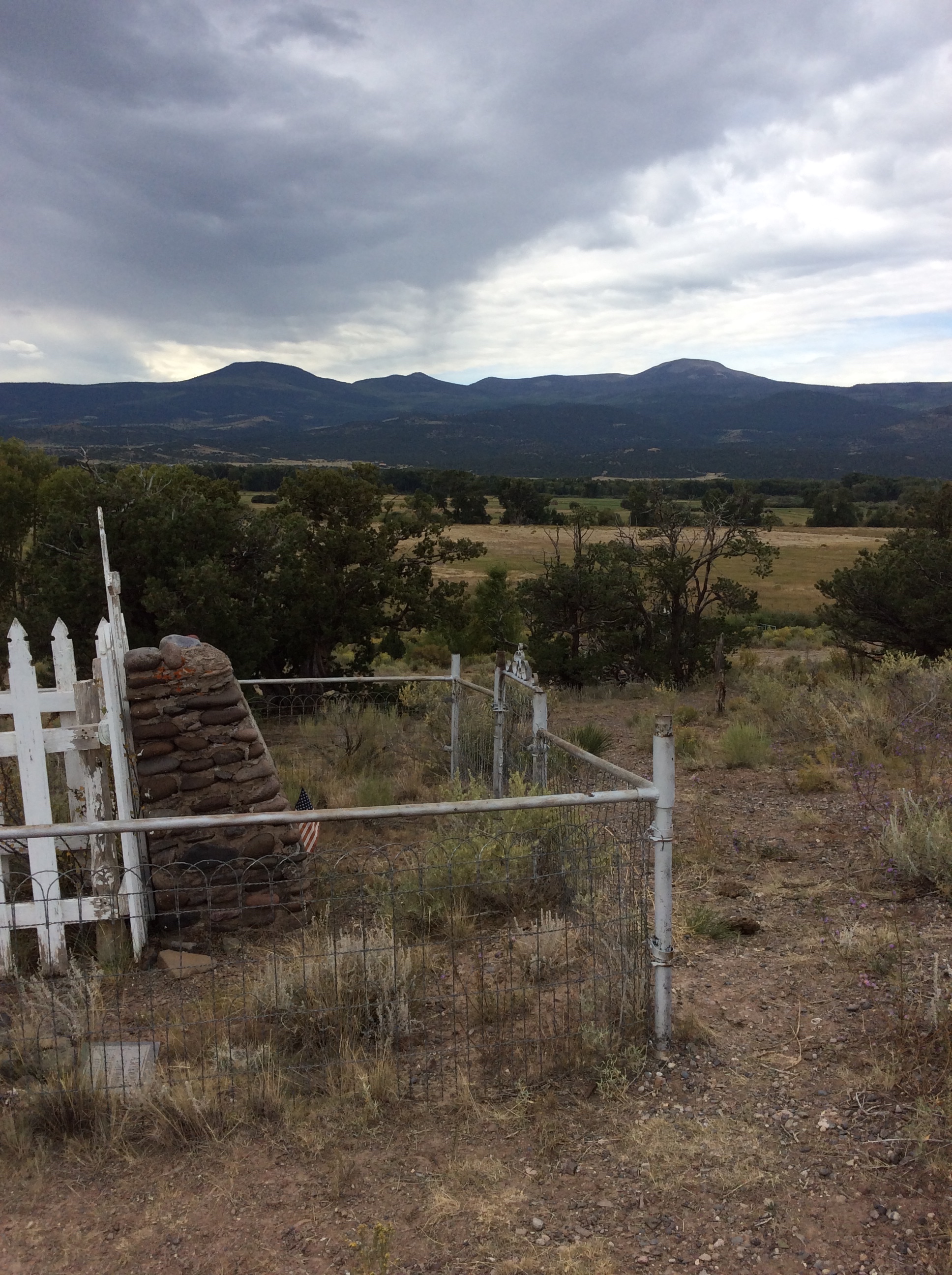
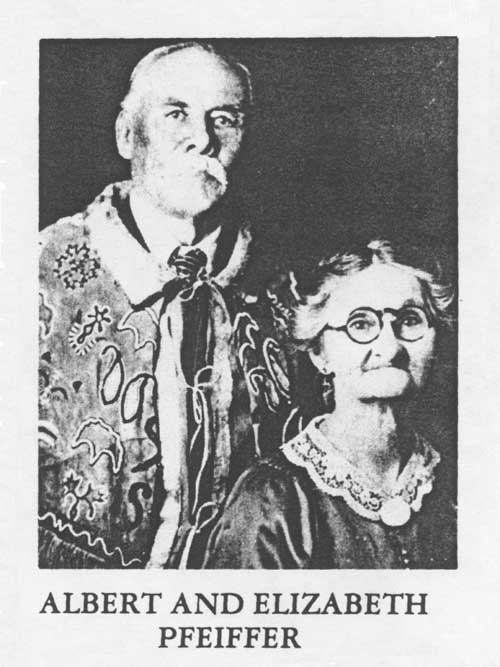

11 replies on “Ghost Hunt, Part 5. The Ghost Who Haunted My House?”
Your story about Lizzie loaning the coat is WRONG. As my Grandmother Glen Dean Pfeiffer loaned them to coat as well as the picture. Having handled all this family history in my youth I cherished it as I did the story.
The story is clear in my head as the letters I used to read not knowing what they were from family past. They coat was passed down from my great great Grandfather to my great Grandmother Ossie Morse. Who then passed them on to her daughter my grandmother, the one who sent the museum some pics & the jacket in 86′. She held onto Lizzies dress for another 15 years I think not positive, before sending it along with some letters to the museum.
I hope my Grandmother is friendly and you are having fun with her.
GlenDean Morse/Ossie Pfeiffer’s daughter my grandmother & great grandmother.
Hello Cameron,
Thank you so much for correcting me.I am sorry for the error. I obtained this information from the following article:
http://www.tylersturf.net/tt/family/pfeiffer/lizzie-doc-02.html
Which reads:
“She (Elizabeth Pfeiffer) loaned the Museum her greatest treasures: the Apache coat with bead work which is now almost priceless, because it is a lost art with the Indians and also because the Chief who wore it was killed by her father-in-law; (This coat is now in the Rio Grande County Museum.) and two letters written by Kit Carson to the same Colonel Pfeiffer. Her ready wit and gay manner made such a hit that she held an impromptu reception following the meeting and gained hundreds of new friends to add to her long list.”
Your comment warrants more investigation on my part. I will vote in Del Norte (location of the Rio Grande County Museum) on Tuesday. I will stop in and see what I can find and report back to you and my readers.
I find Colonel Pfeiffer’s story fascinating and am considering writing a book on him. But, as you well know, information on this great American hero and his family is spotty at best. Any further information you are willing to share would be appreciated. I would like to do a book similar to the recent movie “The Revenant,” but I want to stick to fact more closely than this movie did.
Lizzie is great fun and I feel her presence as I write this. She is a happy soul but doesn’t like it when we leave for a visit to Texas to see my daughter and her family. My grand daughter, who seems to have inherited my sensitivity to the fourth dimension, is quite connected to Lizzie. She often says she has been playing with Lizzie or sees signs of Lizzie.
Lizzie is as others have reported:
“All who knew Elizabeth Chamberlain Pfeiffer were better for having the experience of knowing this winsome, happy and optimistic little woman whose friendship was so broad and generous. Her buoyant personality made one feel better for being alive and to believe as she did as she expressed the reason life was good to her. “The good Lord has always helped”.” http://www.tylersturf.net/tt/family/pfeiffer/lizzie-doc-01.html
You are fortunate to be entwined with this inspiring American heritage.
Please forgive my tardiness in responding. I was recently needed by my daughter for an extended stay. I found that my needed help left me little time to write. (If you wish to contact me privately, please email me at claragbush29@gmail.com)
Thank you again.
With Warm Regards,
Clara.
UPDATE!
Hi Cameron and Readers,
I wanted to update everyone on my findings today. I visited the Rio Grande County Museum in Del Norte, Co and found amazing things. I will do a full blog in the future on what I learned about Lizzie and the Colonel.
The Colonel’s coat is there, however, according to the Director of the Museum, and a 1981 official document titled: LOAN AGREEMENT, the coat is on loan from Charles Elliott—who is still alive today and over 100 years old. Elliott is the great grandson of Colonel Pheiffer.
There is conflicting information connected to the stories about the Colonel. One I will mention is in the article I used for research, it states that the coat had belonged to an Apache Chief. On the Loan Agreement, the document reads: Comanche Chief’s beaded coat.
The Director of the Museum suggested I research the news articles and the Colonel’s obituary she has on file. Hopefully, I will find answers.
Im an idiot Clara I was a little confused in my memories an arrogant in my statement and I apologize. The dress is what my Granny had for so many years as well as a record of Lizzie giving the oral history of my Grandfather. I became ill a few years back and just had scatter brains for a couple years do to an infection. No excuse for going off half-cocked. Thank You for your reply to me with the information that was provided as it is accurate. What have I learned from this? Dont post while on prescribed pharmaceuticals, they are still drugs and make ya dumb.
Hey Cameron,
Great to hear from you again. Pharmaceuticals or not, I loved getting your comment. It motivated me to go to the Del Norte Museum and investigate further. An adventure I thoroughly enjoyed, so, thank you. Sure hope you are all well now, and please don’t hesitate to question my findings or add your own. I enjoy learning and hearing from my readers. —Clara
Hello. I am just now reading this history. I looked up the name of Albert Pfeiffer from the “old” typed copy of my Grandmother’s, Mrs. Chester Mathias, and found all this history now on-line. I am SO thrilled to find all this. I don’t know who typed it. My Grandmother was one of Grandma Pfeiffer’s close friends. It is possible that I even may have met her. Thank all of you for your work to get these stories out.
Hello Loris,
Thank you for commenting. Very interesting indeed. The Colonel was quite the hero and such a colorful figure in our history. Unfortunately, I haven’t had the time to dig into the research the director of the Del Norte Museum so kindly offered, but it is an endeavor that is dear to my heart, so I will not let it slide. Promise. —Clara
Hello Clara my name sadie diana vasquez. Mainden name sadie D. Mortimore, I’m the. Great great granddaughter of captain William mortimore, 3rd.regament civil war, new mexico. Captain William mortimore , and col. Albert h. Pfeiffer was good friend ‘s. So I Have read from the history of the civil war. Your story on Albert h.pfeiffer was vary untrusting. My dad is Albert Jose mortimore ww2 staff sargent, his father , Pacifico mortimore. Yes so Thankyou for your time . also I read captain William and Albert h.pfeiffer had a land grant. To geather, any way I’m trying to find a picture of my. Great great grandfather William and. Albert h.pfeiffer . haveing a bit of aproblem!!need help. Thankyou sadie diana mortimore vasquez.
Aurora, Colorado. Gmail is,
Mortimoresadie78.@gmail.com
So nice to meet you, Sadie! Thank you for reading my blog and replying. I am happy to help any way I can. The Rio Grande County Museum in Del Norte, Colorado has much information on Colonel Pfeiffer. We may be able to find the information you are looking for there. The director of the museum, Louise Colville, has given me permission to go through files on the Colonel and that time period. Let me know if you’d like me to go to the museum and see what I can find.
This is so very interesting that you are connected to the Colonel. I find him and his legacy fascinating. Thank you again, for sharing. —Clara
Thankyou!! I know your vary busy Lady” I did find Albert H. Pfeiffer’s picture.but. can’t find any of my Great,great grandfather.?? Yes if could find. Something at. The museum” about captain William Mortimore,when you get. A chance. Don’t rush I know you area busy Lady.. Thank’s again.
Sadie D.mortimore vasquez.God Bless Clara.andI. I Love books” I Love to read. Bye bye.😸🙏